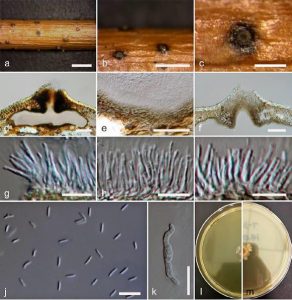Cytospora salicacearum Norphanphoun, Bulgakov, T.C. Wen & K.D. Hyde, sp. nov., Index Fungorum number: IF552610
Etymology: The specific epithet salicacearum refers to host plant family Salicaceae, on which the fungus was first collected.
Holotype: MFLU 15-2061
Associated with twigs and branches of Salix alba L., Salix × fragilis L. [S. alba L. × S. euxina I.V. Belyaeva], Populus nigra L. var. italica Münchh. and Prunus cerasus L. Sexual morph: Undetermined. Asexual morph: Conidiomata 570–750 × 320–380 μm diameter, semi-immersed in host tissue, solitary, scattered, erumpent, discoid, circular to ovoid, with 1–2 locules, ostiolate. Ostioles 160–200 μm diameter, at the same level as the disc surface. Peridium comprising a few to several layers of cells of textura angularis, with inner most layer thin, dark brown, outer layer dark brown to black. Conidiophores unbranched or occasionally branched at the base, reduced to conidiogenous cells. Conidiogenous cells blastic, enteroblastic, phialidic, formed from the inner most layer of pycnidial wall, hyaline, smooth-walled. Conidia (3.6–)4.9–6.4 × 0.9–1(–1.1) μm (x̅ = 5 × 1 μm, n = 30), unicellular, allantoid to subcylindrical, hyaline, smooth-walled.
Culture characteristics: Colonies on MEA, reaching 1.5 cm diameter after 7 days at 25 °C, producing rhizoid mycelium, undulate, margin rough, white, lacking aerial mycelium.
Material examined: RUSSIA, Rostov Region, Shakhty City, steppe slopes near Grushevsky pond, osier-bed near pond, on dead and dying branches of Salix alba (Salicaceae), 14 May 2015, T. Bulgakov, T-357 (MFLU 15-2061, holotype, KUN, isotype), ex-type living culture, MFLUCC 16-0509, KUMCC; RUSSIA, Rostov Region, Shakhty City, steppe slopes near Grushevsky pond, riparian grove, dead and dying branches on Populus nigra L. var. italica Münchh (Salicaceae), 14 May 2015, T. Bulgakov, T-393 (MFLU 15-2097, KUN), living culture, MFLUCC 16-0576, KUMCC; RUSSIA, Rostov Region, Krasnosulinsky District, Donskoye forestry, old orchard, dead and dying branches on Prunus cerasus L., 18 June 2015, T. Bulgakov, T-503 (MFLU 15-2207, KUN), living culture, MFLUCC 16-0587, KUMCC; RUSSIA, Rostov Region, Krasnosulinsky District, Donskoye forestry, riparian forest, on dead and dying branches of Salix × rubens Schrank [S. alba L. × S. fragilis L.] (Salicaceae), 18 June 2015, T. Bulgakov, T-509 (MFLU 15-2213, KUN), living culture, MFLUCC 15-0861, KUMCC.
Notes: Cytospora salicacearum has 1–2 loculate conidiomata with a single ostioles and shares common walls. In the phylogenetic analyses based on combined ITS, LSU, RPB2 and ACT sequence data, C. salicacearum is a close relative to C. melnikii (MFLUCC 15-0851, MFLUCC 16-0635) and C. chrysosperma (HMBF17, HMBF151, HMBF158, HMBF159). However, they are different in morphological characteristics, C. melnikii and C. chrysosperma differ from C. salicacearum in having shorter and wider conidia (4.6 × 1.2 μm, 4.6 × 1.2 μm, 5 × 1 μm, respectively).
Cytospora salicacearum differs from C. melnikii and C. chrysosperma in the polymorphic nucleotides of the RPB2 and ACT sequence data. In RPB2 it differed with 35 polymorphisms from C. chrysosperma, four polymorphisms from C. melnikii. In ACT it differed with eight polymorphisms from C. chrysosperma and differs from C. melnikii with four polymorphisms.
FIG: Cytospora salicacearum on Salix alba (MFLU 15-2061, holotype). a Stromatal habit in wood. b Fruiting bodies on substrate. c Surface of fruiting bodies. d Cross section of the stroma showing conidiomata. e Peridium. f Ostioles. g–i Conidiogenous cells with intact conidia. j Mature conidia. k Germinating spore. l, m Colonies on MEA (l-from above, m-from below). Scale bars: a = 2000 μm, b = 1000 μm, c= 400 μm, d = 100 μm, e = 50 μm, f = 100 μm, g, h, i, j = 10 μm, k = 20 μm.

